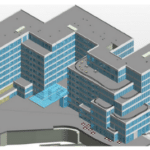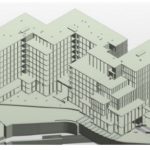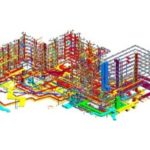MEETING USER EXPECTATIONS is pivotal to the role of architects as they address design intent, functionality, space usage, aesthetics, and other details.
However, it’s equally critical for any architect to keep their eyes on the budget, schedule, and overall project plan. Design variations due to inaccurate dimensions, unmanaged revisions, schedules going haywire and data inaccessibility often prove to be major impediments in project construction.
Robust tools for accurate and optimized design, integrated workflows, modeling, coordination, and project documentation can help overcome these challenges.
BIM enables architects to gain greater project insights early on in the construction. BIM’s detailed three-dimensional view of the project along with sequencing and cost estimation capabilities allows architects to revisit and revise plans if needed. With BIM, architects are better positioned to enhance collaboration and productivity, while keeping costs under control.
An architecture firm from Manchester, UK required a 4D BIM coordinated with construction sequencing and project introduction video. The challenges included understanding technical instructions in a foreign language and an inter-woven building with five levels and a lack of MEP drawings. Using Autodesk Navisworks, a 4D BIM model simulation was created that helped improve design-intent, communication with stakeholders, cost reduction, and rework. Read the case study here.
7 Reasons for BIM
So what are the seven reasons for BIM for architects?
The current need to include remote workflows is challenging for construction projects, and BIM is the perfect solution to support that change. With BIM at the forefront, architects can create new assessment options, de-risk projects, and produce superior processes and outcomes. Let’s go through seven key reasons for BIM.
1 – Quick modeling and testing
BIM offers a host of opportunities for 3D modeling and structural assessments. Architects can use BIM to experiment with new designs and materials. 3D elements like doors, walls, et cetera that appear on elevations, sections, views, and schedules help architects save cost, resources, and accommodate client timelines. BIM makes building design and testing quicker wherein the construction process can start earlier. It also helps project stakeholders make informed calls early in the design process.
2 – Improved communication with the client
BIM provides a strong way to pitch projects. In addition to building 3D models for structural applications, these models can be used to showcase designs. These designs help clients to explore the building before it goes onsite through improved communication and collaboration. Creating stunning visualizations through 360 renders, illuminance studies and VR model walkthroughs gives clients a clear perception of the project. Architects can even explore powerful BIM tools to increase the possibilities of business performance and growth.
3 – Enhanced coordination and collaboration
BIM creates an enhanced collaborative workspace with processes that enable reduced administration and an improved focus on project development and deliverables. Using new standards for best practice design, cost-effective construction, and efficient material use is the result of an error-free 3D coordinated model. Architects can coordinate and collaborate with specialist trades and teams to ensure every design, system, and structure is well-coordinated.
4 – High-quality error-free parametric models for buildings
Before architects adopted BIM, there was a significant possibility of human error that could lead to massive project complications. BIM has the potential to significantly reduce these problems through quick information transfer, better design documentation, parametric modeling for objects, et cetera. With detailed visualization for height, width, depth, scheduling, and cost estimation, all in harmony, the highest quality of buildings can be achieved.
5 – Quick quantity takeoffs
BIM eliminates the need for manual processes and working in silos. Information-packed 3D models help generate quick and accurate takeoffs to provide a precise cost estimate for better decision making. It also enables better communication between the architect and the subcontractor to accurately generate quantities of the required material. Based on parametric modeling capabilities, architects can evaluate alternative design capabilities based on the cost aspect.
6 – Highly detailed models with LOD covering every aspect of buildings
Traditional 2D or 3D drawings don’t distinguish between various elements. BIM incorporates the ability to manage information in greater detail through the entire lifecycle of the project. It includes conceptual and detailed design, analysis, documentation, operations, logistics, manufacturing, and other information. The 3D model can be used as an underlay to produce details that makes the process very efficient.
MORE: New report by Asite on optimizing construction industry’s digital engineering
Architects can check these 3D designs and monitor design development. The level of detail for BIM models holds crucial information about the exact make, model, specifications, material, and quantities. With real products and materials included, architects can leverage improved work quality, better decision making, and reduction in project costs.
7 – Accurate environmental impact analysis
Using the sustainability or sixth dimension, architects can analyze the impact of buildings on the environment. This helps architects make data-driven decisions about the usage of energy-efficient materials and effective regenerative designs. BIM can also be adopted through energy modeling for better reliability, consistency, and usability of energy, accurate energy estimates, improved cost analysis, etc.
BIM Holds The Key
BIM has proven to be a highly reliable construction technology for architects with advanced features and a comprehensive set of digital tools. Customized scripting allows users to build powerful and bespoke programs to make design processes efficient and sustainable. Dynamo, integrated with Revit, perform calculations, builds complex shapes, and automates processes. Adopting Revit to automate Revit families for façade, families, framing or panels helps generate a fully-realized BIM model.
Architects can use automation to easily create repetitive designs, build custom forms and prepare project-specific reports. With the host of benefits that BIM provides to architects, architects can truly think out of the box and cater to their client’s needs underpinning the various features of BIM.
About the Author
Bhushan Avsatthi is an Associate Director at Hitech iSolutions. Bhushan imbibes the prophecy of efficient and prudent use of energy in his day to day life and encourages his team to do so as well. He is also involved in green initiatives like the nonprofit Tree Plantation Project and promotes using cycles for commuting small distances. Bhushan manages a team of Architects, Structural and MEP engineers, LEED consultants, and Energy modeling experts.







Reader Comments
Comments for this story are closed